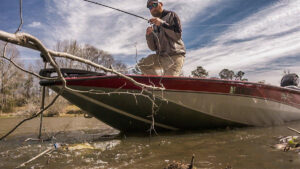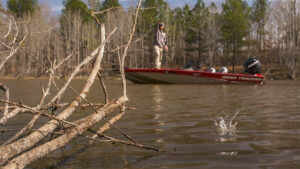If you were to drop any red-blooded bass angler onto a random lake, we’d probably all look for some sort of wood cover. Big bass have a well known affinity for it, as it provides both shade and strategic ambush points for feeding opportunities.
I’ve guided fishing trips for quite some time and have seen many clients become frustrated while attempting to fish wood cover due to constant snags and hang-ups. Whether it’s a laydown or a brush pile, I believe these tips will greatly minimize your irritation and maximize your fish catches.
No. 1: You’re fishing too fast.
I wanted to talk about this first, because in all honesty, this may be the root of all your wood-fishing problems. After a few hours with no bites, it’s quite easy to lose concentration and begin rushing your retrieve. You’ll start huffing and puffing and before you know it, you’re totally zoned out and snagged in the best-looking laydown of the day.
It stinks. I’ve been there.
When you’re fishing wood, it’s imperative to keep track of your bait at all times. As tough as it may be, you need to visualize your bait crawling over each individual branch. After a little practice, you can almost feel when you’re about to get wedged and you’ll have a better chance of avoiding a hang-up.
If you simply cast your Texas rig, jig or any other bottom-contact presentation into wood cover and immediately employ the stereotypical lift up-reel down retrieve, two things are going to happen: You’ll cause too much commotion and spook the bass or you’ll wedge your hook point or weight into a limb.
An easy rule of thumb: If you’re not counting each limb as your bait comes over it, you’re fishing too quickly. It might sound crazy, but try it on your next trip. I guarantee you’ll spend less time retrieving your snagged bait.

No. 2: Your rod tip is too low.
In my opinion, this is another consequence of losing concentration and possibly fishing too fast. You’ll start talking to a buddy, checking out the big lake house or counting squirrels in someone’s backyard and without even realizing it, you’re dragging your rod tip to the side instead of upward.
Let’s think about what this is doing underwater: When your rod tip is low—below the 3 o’clock position—you’re now pulling that bait into the wood. In the case of a jig or Texas rig, your weight is now in prime position to wedge itself in a forked branch. If you keep your rod tip above the 3 o’clock position, however, you’re pulling your bait over each branch.
A lot of your bites are going to happen on the fall, so it’s important to keep that rod tip high and let your bait fall to the bottom after it comes over each branch. A high rod tip will ensure that your bait has plenty of opportunities to fall into the optimal strike zone.
An easy rule of thumb: If you’re rotating your hips or torso while you’re dragging a bottom-contact bait through wood cover, your rod tip is probably too low. Stick with an up-and-down rod motion and you’ll come through the nasty stuff much easier.
No. 3: Your weight isn’t pegged.
Of course, this only applies to a Texas rig, but regardless, you’re going to get snagged a lot more if your weight isn’t pegged. Some people use toothpicks, but I think they damage the line too much. Instead, I opt for the VMC Sinker Stops; they’re cheap and they keep my sinker snugged up to the head of my Texas rig without any slipping.
Here’s the reasoning behind it: You want your whole Texas rig to come through the cover as one, cohesive unit. When your weight is not pegged, the weight slides freely on the line and now you have two potential snag opportunities—your weight and your hook. A pegged weight essentially cuts your chances of hang-ups in half.
In addition, it also helps your bait fall through the limbs without the need to shake and jiggle your rod tip, which can potentially spook wary bass.
An easy rule of thumb: If you’re fishing a visible laydown, make sure you peg your weight. When you’re fishing open water, an unpegged weight will actually give your bait more action, but I don’t suggest it when the cover is thick. If you’re able, it’s a good idea to rig up two Texas rig rods for each situation.
No. 4: You haven’t checked your bait in a while.
After you’ve fished with a soft-plastic bait for a while, it’s going to get worn out and become a bit softer. As this happens, the back-side of the bait—where the hook point penetrates—will begin exposing the hook point. This will cause a lot of snags throughout the day, even if you’re following all of these other steps.
I’m pretty picky about this, so that’s why I never go fishing with just one pack of my favorite colors in my boat. The minute my bait starts getting chewed up, I’ll discard it and rig another one. I keep the staple colors—green pumpkin, watermelon red and junebug—in healthy supply.
An easy rule of thumb: I suggest checking your bait after every three or four flips or pitches. It doesn’t take a long, meticulous inspection. If your hook point is still covered, you’re probably good to go.

No. 5: You might be going overboard on your rod and line.
This is probably the point that’s going to garner the most discussion, which is fine. Just because I do it this way, doesn’t mean it’s right for everyone. But I rarely use heavy-action rods and braided line when I’m fishing wood cover.
Let’s start with the line selection first: There have been too many times when I’ve seen braid “saw” into branches and ruin both casts and hooksets. Braided line is much more abrasive than fluorocarbon, so when you put abrupt pressure on that line (i.e. hooksets), it can cut into the wood and cause a lot of problems. Rarely can you dislodge these types of snags without trolling to the tree and manually retrieving your bait.
When it comes to rod selection, I rarely use a heavy-action rod when I’m pitching and flipping wood. Now, if I’m flipping flooded bushes in the spring with the chance of catching an 8-pound female, that might change. But for ordinary laydowns and the like, I’ll tone it down a notch.
This completely revolves around the fact that I want some extra sensitivity in these situations. I need to feel when my line and/or bait is yo-yoing over a branch. I need to feel when my line is sliding down a branch towards the fork. This sensitivity allows me to detect potential mistakes before they happen. If you’re using a broomstick, you’ll probably feel your bites, but you’ll miss a lot of those small nuances that make a big difference.
An easy rule of thumb: When I’m using a weight between 1/16 and 1/4 ounces, I’m usually going to choose a medium heavy-action casting rod with 15 to 17-pound fluorocarbon line. When I bump up to a 3/8 or 1/2-ounce weight (or jig), I’ll actually use a 3/4 heavy-action rod and 20 to 25-pound fluorocarbon. I’ve found that these setups give me the sensitivity I’m looking for without sacrificing any hook-setting power.












